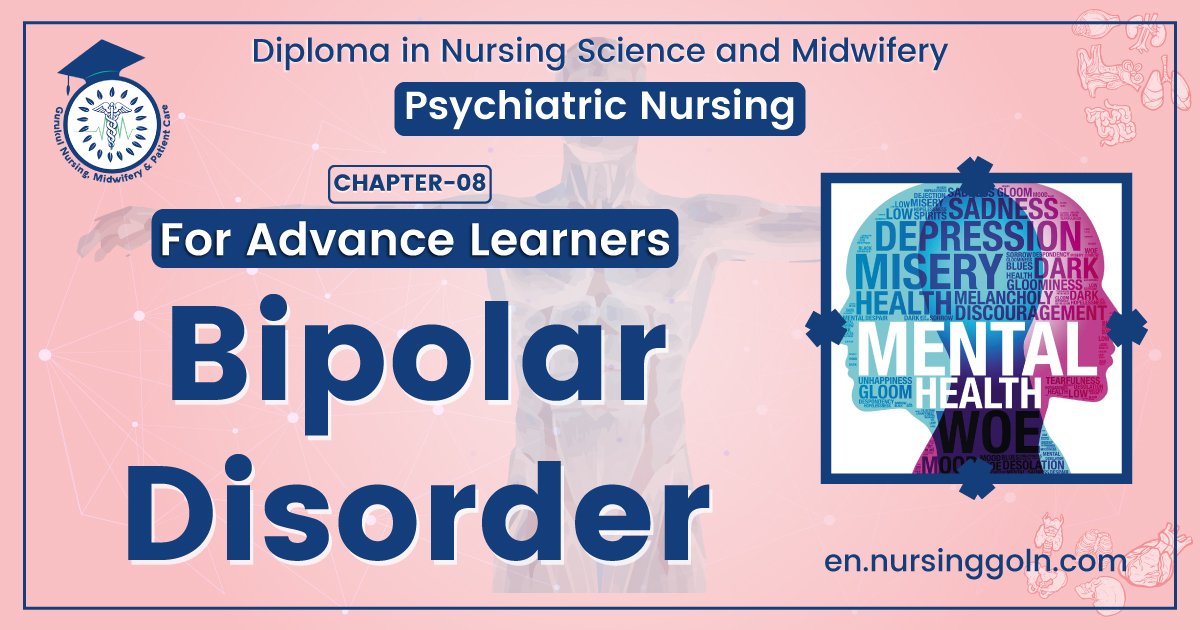Bipolar disorder – This book covers the entire syllabus of “Psychiatric Nursing” prescribed by the Universities of Bangladesh- for Basic and diploma nursing students. We tried to accommodate the latest information and topics. This book is an examination-friendly setup according to the teachers’ lectures and examination questions.
At the end of the book previous university questions are given. We hope in touch with the book students’ knowledge will be upgraded and flourish. The unique way of presentation may make your reading of the book a pleasurable experience.

Bipolar disorder
Bipolar disorder:
It is a brain disorder that cause unusual shifts in a person’s mood energy and ability to function: W. It is a long term illness which has to be carefully managed throughout a person’s life’.
Classification of bipolar disorder:
1. Type I Bipolar-Episodes of mania and major depression.
2. Type II Bipolar-Episodes of mania, hypomania and major depression
3. Type III Bipolar-Episodes of major depression
4. Type IV Bipolar-Consists of all other forms of bipolar disorders
[ Ref: Kp Neeraja Vol-2/389-390]
Etiology of bipolar disorder:
Biological Factors
Heredity:
1. Genetic predisposition is common, life time risk is noticed in first-degree relatives of the client.
2. If one parent suffers, 25 percent chance for children to have the disorders, if both parents are suffering, 50-75 percent chances to occur in children.
3. Twins are more predisposed, a higher percentage (40-70%) is observed in identical/monozygotic/unioyular twins than in dizygotic twins (20%)
Biochemical factors:
- Imbalances in catecholamine (Norepinephrine, dopamine) levels or its functions obliterate results into MDP. If catecholamine amounts are increased mania, will occur, decreased levels predisposes for depression.
- Deficiency in serotonin levels results in MDP.
- Deficiency in GABA, acetylcholine contributes for mania occurrence.
- Cyclo-thymic personality
- Effects of physical illness:
- . Brain disease
- Endocrine disorder
- Certain infections like HIV
Social Factors
- Stressful life events, traumatic or unpleasant or disturbing life experiences
- Social pressures
- Rejection of children by parents
- Difficult or strained interpersonal relationships; interpersonal loss, interpersonal role
- dispute or transition or deficits
- Socio-cultural factors
- Loss of loved one (real or symbolic)
- Financial difficulties
- Unemployment, poor job opportunities
- Criticism and rejection
[Ref: KP Neeraja/1/Vol-2/3911]
Clinical features of bipolar disorder:
Manic episode:
1. Affect/moods:
- Euphorically elevated, overly happy, outgoing
- Irritable mood, agitation, jumpy, “wired”
- Inappropriately joyous
2. Behaviors:
- Increased goal-directed activity
- Excessive involvement in high-risk activities
- Impulsivity
- Restlessness
- Energized behavior
- Clothing may look disorganized or disheveled
- Increased psychomotor changes
- Religiosity
- Decreased need for sleep
- Behavior may become aggressive, intrusive, or combative.
- No patience or tolerance for others
- Increased talkativeness or rapid, pressured speech
3. Thoughts:
- Inflated self-worth
- Expansive and optimistic thinking
- Flight of ideas and/or loose associations
- Racing thoughts and feeling that their minds are active
4. Perceptions:
- Approximately, three fourths have delusions
- Manic delusions reflect perceptions of power, prestige, position, self-worth, and glory
- Some have auditory hallucinations and delusions of persecution.

Hypomanic episode:
1. Affect/moods:
- Up
- Expansive
- Irritable
2. Behaviors:
- Busy
- Active
- Over involved
- Increased energy
- Increase in planning and doing things
- Others notice the increase in his or her activity but the patient often denies that anything about him or her has changed
3. Thoughts:
- Optimistic
- Future focused
- Positive attitude
4. Perceptions:
- Patients with hypomania typically do not experience perceptual changes.
MDE:
1. Affect/moods:
- Sadness dominates affect and is often blunted or flattened
- Feeling sad, depressed, empty, and isolated
- Hopelessness
- Helplessness
- Worthlessness
- Easily overwhelmed
2. Behaviors:
- Poor grooming
- Increased tearfulness
- Poor eye contact or no eye contact
- Psychomotor changes: moves slowly or moves very little, with psychomotor retardation
- Social withdrawal, shyness, or increase in social anxiety
- Decreased interest in sexual activity and or dificulty enjoying al activity
- Somatization (e.g., increase in physical or somatic complaints without objective identified able cause)
- Difficulty with attention and concentration
- Appetite disturbances (increase or decrease)
- Sleep distarbance
- Decrease in energy and increase in fatigue regardless of amount of sleep
- Attempts at suicide
3. Thoughts
- Increased thoughts of death or morbid thoughts, and/or suicidal thoughts or specific plans for committing suicide
- Thoughts that reflect their sadness (negative thoughts about self world, and future)
- Nihilistic concerns
- Short-term memory deficits
- Increase in worry and rumination; also referred to as brooding
- Inappropriate guilt.
Management of bipolar disorder:
Acute Treatment:
1. The primary goal of the acute phase is to manage acute mama, hypomania, or depressive episodes, and associated safety-risk issues
2. Diagnostic tests should be performed to rule out potential medical etiologies for mood symptoms, especially if this is the first episode of mania, hypomania, mixed mood symptoms, or depression.

Nursing Management for Bipolar Disorder
Nursing management of a patient with bipolar disorder includes the following:
A. Nursing Assessment
Assessment of a patient with bipolar disorder include:
1. History. Taking a history with a client in a manic phase often proves difficult; obtaining data in several short sessions, as well as talking to family members, may be necessary.
2. General appearance and motor behavior. Client with mania experience psychomotor agitation and seem to be in perpetual motion; sitting still is difficult; this continual movement has many ramifications; clients can be exhausted or injure themselves.
3. Mood and affect. Mania is reflected in periods of euphoria, exuberant activity, grandiosity, and false sense of well being.
4. Thought process and content. Cognitive ability or thinking is confused and jumbled with thoughts racing one after another, which is often referred to as flight of ideas; clients cannot connect concepts, and they jump from one subject to another.
B. Nursing Diagnosis for Bipolar Disorderte
Nursing diagnoses commonly established for clients in the manic phase are as follows:
1. Risk for other-directed violence related to manic excitement, suspicion of others, paranoid ideation,
2. Risk for injury related to extreme hyperactivity, destructive behaviors
3. Imbalanced nutrition: less than body requirements related to refusal or inability to sit still long enough to eat meals
4. Disturbed thought processes related to psychotic process
5. Disturbed sensory perception related to sleep deprivation, psychotic process

C. Nursing Care Planning and Goals
Nursing care planning goals for bipolar disorders are:
1. The client will no longer exhibit potentially injurious movements after 24 hours with administration with administration of tranquilizing medications
2. The client will experience no physical injury.
3. Client’s agitation will be maintained at manageable level with the administration of tranquilizing medications during first week of treatment.
4. Client will not harm self or others.
5. Client will consume sufficient finger foods and between theat shacket recommended daily allowances of nutrients.
6. Within one week, client will be able to recognize and verbalize when thinking is non- reality based.
7. Client will be able to recognize and rang the environment inaccurately.
D. Nursing Interventions
Nursing interventions for bipolar disorder client are:
1. Providing for safety. A primary nursing responsibility is to provide a safe environment for client and others, for clients who feel out of control, the nurse must establish external controls emphatically and nonjudgmental.
2. Meeting physiologic needs. Decreasing environmental stimulation may assist, client to relax, the nurse must provide a quiet environment without noise, television, and other Undistractions, finger foods or things client can eat while moving around are the best options to improve nutrition.
3. Providing therapeutic communication. Clients with mania have short attention spans. so the nurse uses simple, clear sentences when communicating, they may not be able to handle a lot of information at once, so the nurse breaks information into many small segments.
4. Promoting appropriate behavior. The nurse can direct their need for movement into socially acceptable, large motor activities such as arranging chairs for a community meeting of walking.
5. Managing medications. Periodic serum lithium levels are used to monitor the client’s safety and to ensure that the dose given has increased the serum lithium level to a treatment level or reduced it to a maintenance level.

E. Evaluation
The goals are met as evidenced by:
1. Client is able to differentiate between reality and unrealistic events or situations
2. Client is able to recognize thoughts that are not based in reality and intervene to stop their progression.
3. Client has gained or maintained weight during hospitalization.
4. There is no evidence of violent behavior to self and others.
5. Client is no longer exhibiting signs of physical agitation.
F. Documentation Guidelines
Documentation in a patient with bipolar disorder include:
1. Individual findings, including factors affecting, interactions, nature of social exchanges, specifics of individual behavior.
2. Cultural and religious beliefs, and expectations.
3. Plan of care.
4. Teaching plan.
5. Responses to interventions, teaching, and actions performed.
6. Attainment or progress toward the desired outcome.
Read more:
